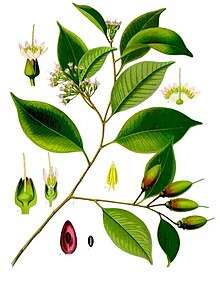Payena leerii
| Payena leerii | |
|---|---|

| |
| Scientific classification | |
| Kingdom: | Plantae |
| Clade: | Tracheophytes |
| Clade: | Angiosperms |
| Clade: | Eudicots |
| Clade: | Asterids |
| Order: | Ericales |
| Family: | Sapotaceae |
| Genus: | Payena |
| Species: | P. leerii
|
| Binomial name | |
| Payena leerii | |
| Synonyms[2] | |
|
List
| |
Payena leerii is a tree in the family Sapotaceae.
Description
Payena leerii grows up to 30 metres (100 ft) tall with a trunk diameter of up to 60 cm (24 in). The bark is greyish brown. The
inflorescences bear up to eight flowers. The fruits are conical and measure up to 4 cm (1.6 in) long. The tree is a source of high-quality gutta-percha.[3]
Distribution and habitat
Payena leerii is found widely in Sumatra, Peninsular Malaysia, Borneo, Sulawesi and the Philippines. Its habitat is coastal lowland forests to 650 m (2,100 ft) elevation.[3]
Conservation
Payena leerii has been assessed as near threatened on the IUCN Red List. It is at risk from conversion of its habitat for urban development and agriculture. The species is present in Borneo's Bako National Park, Kinabalu Park and Mount Palung National Park, which affords a level of protection in these places.[1]
References
- ^ a b Olander, S.B.; Rivers, M.C.; Wilkie, P. & Pereira, J. (2019). "Payena leerii". IUCN Red List of Threatened Species. 2019: e.T61966013A61966015. Retrieved 17 March 2024.
- ^ a b "Payena leerii". Plants of the World Online. Royal Botanic Gardens, Kew. Retrieved 17 March 2024.
- ^ ISBN 983-2181-27-5. Archived from the original(PDF) on 27 September 2013. Retrieved 24 December 2013.

